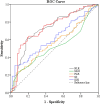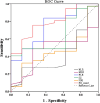Relative value of novel systemic immune-inflammatory indices and classical hematological parameters in predicting depression, suicide attempts and treatment response
- PMID: 39152198
- PMCID: PMC11329510
- DOI: 10.1038/s41598-024-70097-z
Relative value of novel systemic immune-inflammatory indices and classical hematological parameters in predicting depression, suicide attempts and treatment response
Abstract
This study compared the power of the novel inflammatory markers systemic immune inflammation index (SII) and the system inflammation response index (SIRI) versus the classical hematological indices neutrophil-to-lymphocyte ratio (NLR), monocyte-to-lymphocyte ratio (MLR), platelet-to-lymphocyte ratio (PLR), and platelet counts in distinguishing between major depressive disorder (MDD) with and without suicide attempts and distinguishing the non-response to selective serotonin reuptake inhibitor (SSRI) treatment. A total of 139 young adult MDD patients and 54 healthy controls (HC) were included. We found that, in comparison to HC, baseline NLR, PLR, SII, and SIRI were significantly higher in MDD patients, but only NLR and SII had area under the ROC curve (AUC) values greater than 0.7. MDD patients with suicide attempts (SA) showed significantly higher baseline MLR and SIRI, and a tendency to increase NLR compared to those without SA. In terms of AUC, sensitivity, and specificity, NLR was better than MLR, SIRI, SII, and PLR in distinguishing SA. Non-responders to SSRI treatment showed a significant increase in baseline platelet count and PLR compared to responders with an AUC greater than 0.7. These findings highlight the potential benefit of combining novel and classical hematological indices in predicting depression, suicide attempts and treatment response.
Keywords: Depression outcomes; Neutrophil-to-lymphocyte ratio (NLR); Platelet count; Platelet-to-lymphocyte ratio (PLR); Systemic immune-inflammation index (SII); Systemic inflammation response index (SIRI).
© 2024. The Author(s).
Conflict of interest statement
PK and PK are employed by the Bangkok Dusit Medical Services PLC, Thailand. The remaining authors declare that the research was conducted in the absence of any commercial or financial relationships that could be construed as a potential conflict of interest.
Figures



References
-
- Felger, J. C. Role of inflammation in depression and treatment implications. in Antidepressants. (ed. Macaluso, M. & Preskorn, S.) 255–286 (Springer, 2019) 10.1007/164_2018_166 - PubMed
MeSH terms
Substances
Grants and funding
LinkOut - more resources
Full Text Sources

